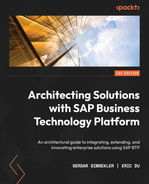2
SAP Business Technology Platform Overview
In the last chapter, we learned about the Intelligent Enterprise framework and how the components and capabilities are brought together to support businesses to become intelligent enterprises that are more resilient, profitable, and sustainable.
While SAP applications enable integrated business processes, companies will require additional flexibility to integrate with existing IT landscapes and extend SAP applications to industry-or company-specific needs. SAP Business Technology Platform (SAP BTP) is the platform for the intelligent enterprise to provide such flexibility, deliver business value through integration and extension, and transform data into value. It also enables different developer personnel to build innovations from a fully flexible programming model to a low-code/no-code model.
In this chapter, we will walk through the technologies behind SAP BTP and give you an overview of the capabilities of SAP BTP and what kind of use cases they support. As we will focus on the breadth of the platform first, there will be many products or terminologies being introduced. If something happens to be new to you, don’t worry, we will explain it when we introduce it the first time or explain it in depth in later chapters. So, it is time for us to discuss the following topics:
- Why SAP BTP is different
- SAP BTP technology capabilities
Why SAP BTP is different
In a nutshell, SAP BTP is the platform of Intelligent Enterprise that provides technology capabilities that help businesses to achieve agility, integration, extension, and creation of value from data. SAP BTP was first introduced in 2019, built on the legacy of SAP Cloud Platform, but it combined all other technology offerings from SAP to finally become a platform that is unified, business-centric, and open.
Unified
SAP BTP is evolving to be a unified platform with a clear focus on business challenges. It brings together all the technology offerings from SAP on one platform. Based on the goal of unification, SAP decided to sunset the SAP Cloud Platform product name and merged the capabilities into SAP BTP, for example, SAP Cloud Platform Integration Suite is renamed SAP Integration Suite.
A unified platform offers a unified experience for customers. SAP is continuing to expand the value of SAP BTP by offering a simplified user experience and out-of-the-box integration and interoperability between SAP applications and technology. The unified platform also provides a consistent commercial model, a simplified platform cockpit, and a catalog of cloud services consumable for different runtimes.
Business-centric
SAP BTP focuses on improving business outcomes and increases business-centricity by being tailored to applications and business processes. It is positioned for use cases along the key integration scenarios mentioned in the previous chapter and enables joint suite-like qualities across the applications, such as a harmonized look and feel, and consistent security and identity management.
The platform includes a semantic layer of business data. The SAP One Domain Model is the common data model that standardizes the key business objects across SAP applications. It is already used in the SAP Master Data Integration service for many master data objects, such as customers, workforce people, suppliers, products, and cost centers. The common data model is also serving as the foundation for APIs and business events, such as SAP Graph, as the simplified and unified API layer for Intelligent Enterprise scenarios. As SAP BTP evolves, the SAP One Domain Model will become more extensible and consumable.
Furthermore, SAP BTP can help companies to gain insights and generate value from data in a business context. It offers semantic data management capabilities through SAP HANA Cloud and SAP Data Warehouse Cloud, to connect enterprise data and break data silos. It automates the process of data integration and life cycle management and delivers cross-product analytics and dashboards to support data-driven decision-making.
SAP BTP also provides built-in security and compliance to ensure data security and privacy for business-critical information. It offers capabilities to help companies to manage enterprise-wide integrations across heterogeneous environments, including their existing IT and hybrid landscapes. SAP Integration Suite as part of SAP BTP can connect and contextualize processes and data, with more than 2,000 pre-configured integration packs.
Open
SAP BTP is an open platform and builds on collaboration with partners and an open ecosystem.
Firstly, SAP BTP runs on top of multiple cloud Infrastructure as a Service (IaaS) layers, for both SAP data centers and through partner cloud infrastructures that give customers flexibility and choice. It offers a consumption-based commercial offering with different payment options and a free tier model to enable access to the broader SAP ecosystem at their pace of adoption.
Secondly, SAP BTP will enable direct access to a growing marketplace where partners and ecosystem participants can build, release, and monetize their solutions directly on the platform, and customers can easily consume them within one commercial model.
Lastly, SAP embraces and actively contributes to open source communities. Open projects Gardener and Kyma are such examples. Gardener is an open source project for multi-cloud infrastructure on top of Kubernetes. Kyma is a cloud-native extension platform. We will cover the details of Gardener and Kyma in a later chapter.
SAP BTP technology capabilities
SAP BTP brings together a comprehensive set of technical capabilities and solutions, (which includes database and data management, analytics, application development and integration, and intelligent technologies) into one platform for both cloud and hybrid environments. Figure 2.1 illustrates how SAP BTP fits into the Intelligent Enterprise framework described in the previous chapter:
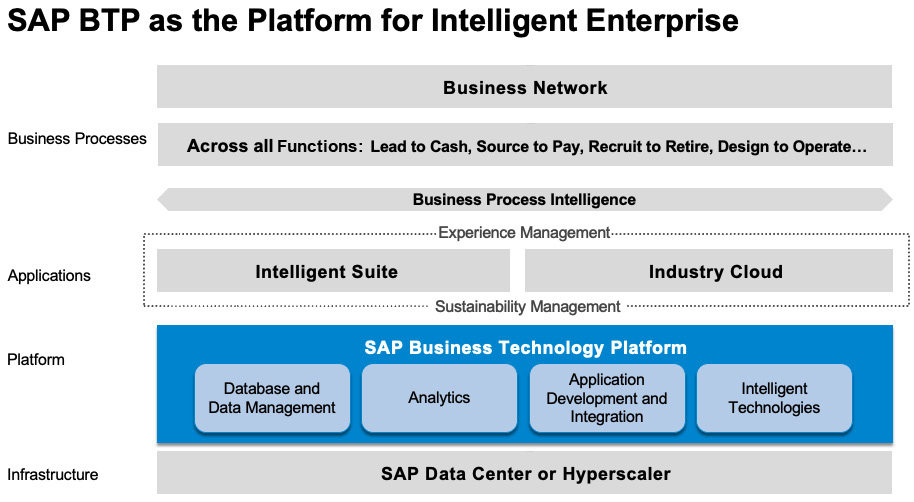
Figure 2.1: SAP BTP in Intelligent Enterprise
Now, let’s get into the details of the technology offerings in each area, starting with database and data management.
Database and data management
Organizations today are faced with the mandate of leveraging all the data assets to optimize business processes. The ability to collect, manage, and analyze data in real time is essential to compete in the digital economy. SAP’s database and data management solutions help to manage enterprise data for their data-driven transformation and priorities. It includes offerings of SAP HANA, SAP HANA Cloud, SAP Data Intelligence Cloud, and more.
SAP HANA
SAP HANA is one of the first in-memory data platforms to handle both online analytics processing (OLAP) and online transactional processing (OLTP) together in a single system simultaneously on the same dataset with unparallel performance. This is important as it enables running complex analytical operations in real time based on the latest information, without replicating data.
Even though SAP HANA is well known as an in-memory columnar relational database management system (RDBMS), it has been taken a step further and provides built-in multi-mode support to store and process data types, such as geospatial, text, graphical, JSON, and time-series data. It also offers advanced search and analytics capabilities, as well as data integration capabilities for all types of data. By applying the built-in advanced capacities such as spatial analysis, text mining, predictive analytics, and machine learning, you can build new types of applications to meet your specific needs and achieve a faster time-to-value. The ability to process different types of data and workloads on a single system also helps to simplify the IT landscapes and reduce operational complexities.
Gaining a unified view of all enterprise data becomes more complex with growing data volumes. It is no longer feasible for a modern enterprise to physically aggregate data into one location. SAP HANA provides native data integration and federation with Smart Data Integration and Smart Data Access, to create a single logical view of data based on a unified security model. Besides, SAP HANA provides intelligent recommendations to simplify administrative tasks such as SQL optimization, data tiering, and monitoring. These capabilities enable a more agile and cost-efficient way to manage data. To support business continuity and high availability, SAP HANA supports a distributed scalable architecture with advanced multi-temperature and data life cycle management capabilities. Active and standby replicas can be deployed in geographically distributed locations for read access, load balancing, and failover through infrastructure automation.
In addition, SAP HANA provides embedded machine learning functions through the Predictive Analysis Library (PAL) and Automated Predictive Library (APL). PAL provides the library with functions in the areas of clustering, classification, regression, time-series analysis, and statistics. APL provides automated predictive functions to generate regression and clustering models based on the dataset, which is simple to use for casual users.
Introduced in 2011, SAP HANA is now used by more than 54,000 customers to manage their critical enterprise data. SAP has also moved the majority of its Intelligent Suite applications off legacy databases onto SAP HANA, including SAP S/4HANA, SAP Ariba solutions, SAP SuccessFactors solutions, and SAP Customer Experience solutions. By doing so, applications can reunify the OLTP and OLAP with a simplified data model and leverage the speed of in-memory processing. For example, SAP Ariba solutions have improved UI response time by 40% on average, with 10 times improvement in search performance. SAP SuccessFactors HXM Suite runs on SAP HANA to enable unified reporting directly on source data with no latency. Query performance has been significantly improved. Besides, simplification of data models increases the speed of innovation.
To summarize, SAP HANA enables organizations to make better business decisions, innovate, deliver new services to their customers, simplify IT, and optimize operational costs. Most Intelligent Suite applications are running on HANA, which enables better integration with a simplified data model and makes cross-product analytics, machine learning, and artificial intelligence (AI) possible based on connected data. Figure 2.2 summarizes the capabilities of SAP HANA:
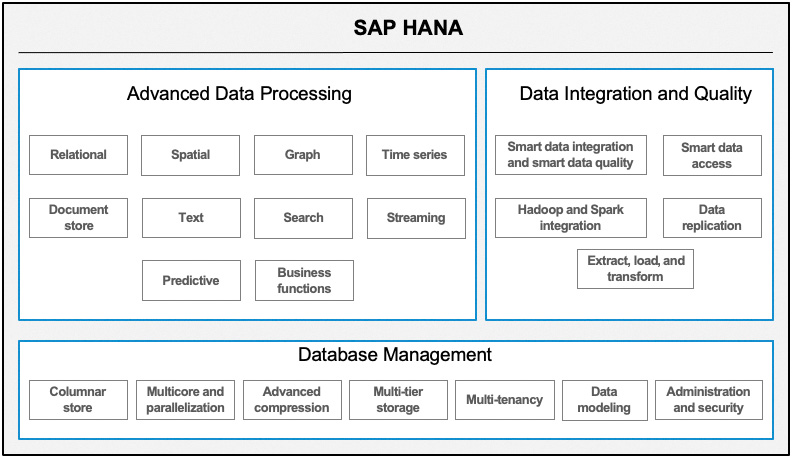
Figure 2.2: SAP HANA capabilities overview
SAP HANA Cloud
SAP HANA Cloud is a data platform-as-a-service that offers SAP HANA natively in the cloud. SAP HANA Cloud inherits the capabilities of SAP HANA to store and process various types of data. In addition, it provides native data tiering with SAP HANA Cloud, Data Lake, and high-volume transaction processing with SAP Adaptive Server Enterprise. HANA Cloud also scales compute and storage resources separately and accesses data according to business needs for performance and provides more flexibility to manage costs.
SAP HANA Cloud includes the following components:
- SAP HANA Cloud – SAP HANA Database is the in-memory database for multi-model data processing that supports OLAP and OLTP in one system.
- SAP HANA Cloud – Data Lake is a fully managed cloud service for securely storing and analyzing large amounts of data that is infrequently updated. It leverages inexpensive storage options to lower costs while maintaining excellent performance and full SQL access to data.
- SAP Adaptive Server Enterprise (ASE) is a fully managed cloud service that enables extreme OLTP workloads in addition to real-time analytical capabilities. The ASE service is fully integrated with shared security and tenancy models, as well as development and monitoring tools. The cloud-native architecture of the ASE service efficiently accommodates independent and elastic scaling of both storage and compute power to handle extreme transaction processing and complex query workloads for many concurrent users.
- SAP HANA Cloud – SAP Adaptive Server Enterprise Replication (ASE Replication) is a high-performance replication system that synchronizes transactional data across ASE instances.
As a managed offering from SAP, you can benefit from guaranteed availability provided by SAP, scale system load based on business needs, and simplified operations such as backup and recovery, and upgrade. SAP HANA Cloud can be accessed through a variety of languages and libraries, such as Java (JDBC), .NET (ADO.NET), Go, Python, and JavaScript. You can create models using tools provided with SAP Business Application Studio, expose data using OData, and bind with applications running on SAP BTP environments. Figure 2.3 illustrates how SAP HANA Cloud connects with data sources and consuming applications:
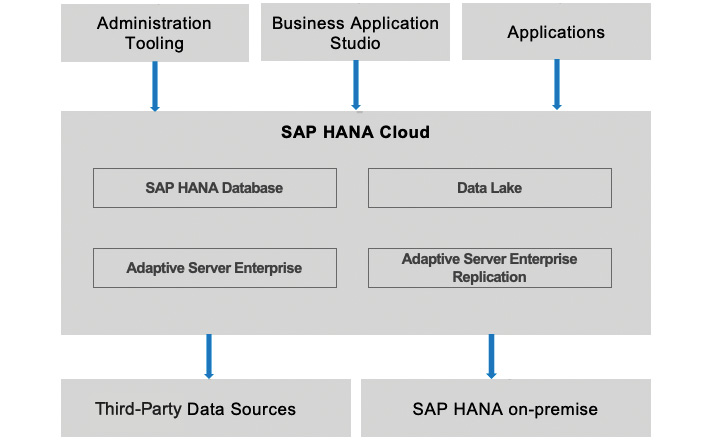
Figure 2.3: Overview of connections to SAP HANA Cloud
Analytics
Analytics solutions as part of SAP BTP provide capabilities to connect and process all types of data. They enable companies to establish a single source of truth with cloud data warehousing, visualize insights with intuitive business intelligence (BI), drive better business outcomes with collaborative enterprise planning, and turn insights into action with automated workflow and augmented analytics powered by AI. In this section, we will highlight SAP Analytics Cloud and SAP Data Warehouse Cloud.
SAP Analytics Cloud
SAP Analytics Cloud is a software-as-a-service (SaaS) solution for analytics that includes BI, enterprise planning, and augmented analytics. This is important, as now businesses can have connected data to make confident decisions. In a nutshell, SAP Analytics Cloud includes the following core components:
- Business intelligence: A powerful combination of BI and analytics enables use cases to range from self-service data discovery and visualization, enterprise reporting at scale, embedded analytics for in-context insights, new analytical applications, and mobile consumption.
- Enterprise planning: To improve accuracy and efficiency for use cases such as budgeting, revenue forecasting, finance, workforce, and predictive planning. Users can simulate and run what-if scenarios to evaluate the pros and cons and determine the best way forward.
- Augmented analytics: Augmented with AI and predictive analytics to drive insights and improve decision-making, and achieved through a series of Smart features. The Smart features include Smart Predict to build actionable predictions, Search to Insights to enter questions in conversational language to get answers instantly, Smart Insights to focus on impact and contributor analysis for selected KPIs, and Smart Discovery to analyze patterns to identify outliers for anomaly detection.
SAP Analytics Cloud runs on top of SAP HANA databases, and users can perform real-time analytics on transactional data virtually through live connectivity. This helps users to view data instantly, and companies can rely on a single source of truth. Embedded analytics are available for SAP’s Intelligent Suite cloud applications, which allows these applications to do reporting on live transactional data directly. For example, SAP SuccessFactors solutions have embedded SAP Analytics Cloud within existing workflows and enable HR professionals to better understand hiring, performance, attrition, and diversity, and to connect how people will impact business results.
Data can come from anywhere, and most businesses will have their own specific datasets. SAP Analytics Cloud, together with SAP Data Warehouse Cloud and SAP HANA Cloud, supports the ability to connect and combine data across enterprise landscapes. This enables organizations to incorporate analytics into existing business processes and accelerate time-to-value with out-of-the-box integration capabilities.

Figure 2.4: SAP Analytics Cloud overview
SAP Data Warehouse Cloud
SAP Data Warehouse Cloud, meanwhile, is a new offering for data warehousing in the cloud that combines data management processes with advanced analytics. It is built on the powerful SAP HANA Cloud and works seamlessly with SAP Analytics Cloud.
SAP Data Warehouse Cloud provides a flexible, cloud-based option for the enterprise data warehouse, and is also designed to empower the line of business for self-service analytics through a business semantic layer. It supports a federate-first approach to reduce or completely avoid upfront data movement and a wide range of connectivity to SAP and non-SAP data sources. SAP Data Warehouse Cloud data objects are exposed as tables and views and can be integrated with external data pipelines and analytics tools. Typical scenarios for using SAP Data Warehouse Cloud include the following:
- Self-service data modeling and analytics by empowering line of business users via Spaces following the governance policies defined by administrators.
- Enable data democratization and lower the adoption barrier with a business semantic layer that abstracts from underneath physical data sources and accelerates time-to-insights.
- Enterprise data warehousing by leveraging SQL skills, built-in data transformation capabilities, as well as third-party and open source tooling for data integration and data processing. It also supports hybrid scenarios such as integration with SAP BW/4HANA (InfoCubes, Queries, and CompositeProviders) to ensure the reusability of BW data or other existing on-premises investments.
The Spaces concept in SAP Data Warehouse Cloud is the central element that provides the necessary isolation and enables collaboration between lines of business (LoBs) and IT to achieve the synthesis of data agility. Enterprise Spaces define and provide governed company-wide standards that can be extended in the departmental and individual Spaces using the same modeling mechanisms of the data and business layer. The individual data objects are only visible within their own Spaces. The data privacy and security rules are space-specific and support the fine granular definition of rules using row-level security. Auditing and activity logs are also supported at the object level.
SAP Data Warehouse Cloud’s Data and Business Modeling services enable users to navigate data. First, the View Editor and Data Flow Editor are used for data modeling by defining connectivity to data sources and implementing complex data integration and transformation logic. Business Builder is the UI that allows data previews with filtering, sorting, profiling, data quality analysis, and basic data lineage. Some of the functionalities that come from SAP Data Intelligence are integrated as a cloud-based software service directly into SAP Data Warehouse Cloud.
As mentioned earlier, SAP Data Warehouse Cloud is closely integrated with SAP Analytics Cloud. Customers who already have a standalone instance of SAP Analytics Cloud can connect directly to SAP Data Warehouse Cloud’s data objects. The two solutions provide a unified look and feel and share the same sets of common services, such as user management, and are delivered from the same data centers. Figure 2.5 is a high-level overview of SAP Data Warehouse Cloud:

Figure 2.5: SAP Data Warehouse Cloud overview
Application development and integration
The application development and integration capabilities of SAP BTP help companies to simplify application development, accelerate integration, automate business processes, and enable full flexibility to meet business needs on an extensible technology platform. As part of the solution package, SAP Integration Suite connects applications and data from SAP and third-party sources with prebuilt flows. SAP Extension Suite simplifies application development using flexible no-code, low-code, and pro-code capabilities to rapidly build and enhance SAP applications and increase development productivity and engagement through a harmonized digital experience.
SAP Integration Suite
SAP Integration Suite combines integration capabilities such as Process Integration, API Management, Integration Advisor, and Open Connectors into a cohesive and simplified toolkit for enterprise integrations. It supports a variety of integration needs including business process optimization and automation, regulatory compliance, and creating new business models leveraging APIs. SAP Integration Suite is the integration layer of SAP BTP.
As you may experience in IT projects, you know a significant amount of time is spent building integrations; that is where the integration packs come to play and accelerate time to results. In SAP Integration Suite, there are more than 2,000 integration packs, 500 documented events, and 225 business process blueprints as part of API Business Hub, which provides a central place to find pre-packaged contents (APIs and integration packs) that contain multiple integration flows that customers can leverage with a few configuration changes, for example, connectivity settings. SAP Integration Suite also includes the Open Connectors capability for non-SAP connectivity, with more than 160 pre-built connectors to third-party solutions via harmonized RESTful APIs. API Management within SAP Integration Suite supports life cycle management of APIs – from design, development, management, and usage analytics to engagement with your developer community, or even monetizing APIs through digital marketplaces. These capabilities help to democratize access to integration and empower business users as citizen integrators to build or reuse integration flows for people with diverse skill sets, rather than fully relying on central IT.
Event Mesh provides the event-driven integration capability. An application can publish a business event. The messaging layer reliably delivers the event for any consumer who subscribes to that and can react accordingly. This enables a loosely coupled architecture that is required for integrating systems or services with a microservices architecture. Today, there are more than 500 published business events from SAP S/4HANA, SAP SuccessFactors solutions, SAP Customer Experience solutions, and more.
Integration Advisor helps to simplify the implementation and maintenance of integration through AI and machine learning. It provides an intelligent content management system that includes a data dictionary with metadata models of APIs and integration contents and a repository of implementation guidelines. It also offers crowdsourcing capabilities for interfaces and mappings and captures them in the knowledge base. By using machine learning and AI, Integration Advisor can automatically generate documentation, mapping guidelines, runtime artifacts, and validation rules for specific integration requirements.
Integration is the key to enabling Intelligent Enterprise, and SAP Integration Suite plays a significant role in integrating both technology and business processes to deliver value by accelerating innovation or reducing the complexity of operations. SAP Integration Suite includes the prebuilt integration packs to support the key business processes, such as lead to cash, source to pay, recruit to retire, and design to operate:

Figure 2.6: SAP Integration Suite overview
SAP Extension Suite
As businesses are moving toward modern technologies and the cloud through digital transformation, maintaining existing applications while adopting emerging technologies becomes an increasingly complex task. SAP Extension Suite provides the necessary capabilities to improve development efficiency and productivity, and support different developer personas for citizens, LoB, or professional developers. With pre-built templates, enterprise-grade frameworks, ready-to-use technical and business services, and standard APIs, developers can build application extensions more quickly, from leveraging low-code/no-code capabilities with fewer IT dependencies to having the flexibility to choose a development approach and runtimes that fit their needs.
There are mainly three types of extensibilities for SAP applications:
- Classic extensibility is the traditional method used to extend applications based on SAP ERP Central Component (SAP ECC) and SAP Business Suite applications. It is tightly coupled, and the customization code usually resides in the Z-namespace directly. Developers and consultants use customization and extension technologies such as ABAP, SAP GUI, and Web Dynpro.
- In-app extensibility was introduced with SAP S/4HANA. It provides the extension framework for building SAP Fiori-based customizations within the SAP S/4HANA system and works with SAP S/4HANA data and processes only.
- Side-by-side extensibility enables decoupled extensions. It helps to extend the business processes while keeping the core clean. It also allows developers to adopt the latest technologies and innovations, such as machine learning and AI, reusable business, and technical services.
Side-by-side extensibility is supported by SAP BTP through SAP Extension Suite, to enable businesses to address their business requirements in a modern way and innovate by adopting the latest technologies. The capabilities and use cases for SAP Extension Suite can be categorized into the following:
- Digital experience: This provides tools to help organizations to build and run applications that provide a consistent and engaging user experience through SAP Fiori-based web applications, mobile applications, and conversational bots. It also includes tools to enable end users to create business content and collaboration such as SAP Work Zone.
- Development efficiency: This offers capabilities to help developers rapidly build extensions and new applications. It includes low-code, graphical development tools, and programming frameworks such as SAP Business Application Studio and SAP Cloud Application Programming Model, which can help to increase development efficiency while ensuring consistent user experience. Multiple runtimes and frameworks are provided to meet different needs, such as Cloud Foundry, function-as-a-service through Extension Factory, and Enterprise Messaging to support event-driven service-oriented architecture. It also offers a low-code/no-code platform including the capabilities acquired through AppGyver.
- Digital process automation: This offers capabilities to automate, adapt, and improve business processes. With the intuitive and business user-friendly tools, users can leverage prebuilt templates to customize their processes or build new ones for their specific business needs. SAP Workflow Management and SAP Intelligent Robotics Process Automation (iRPA) are in this category.
Figure 2.7 gives an overview of the use cases and capabilities that SAP Extension Suite supports:
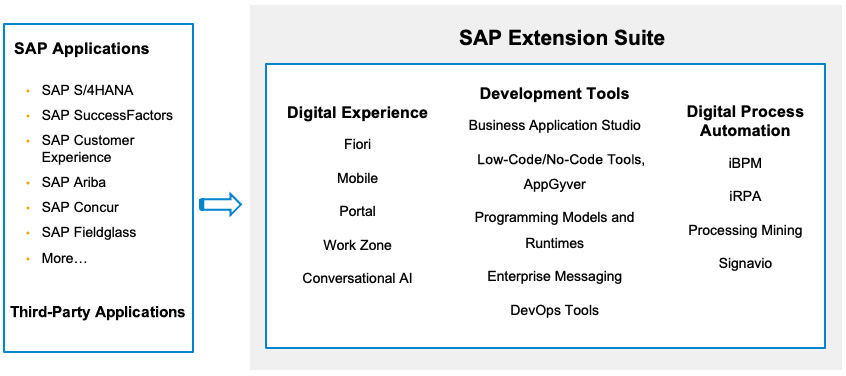
Figure 2.7: SAP Extension Suite overview
Intelligent technologies
With the use of AI, organizations can get better insights to make better decisions, adopt business processes in real time by combining learnings from historic data, automate process steps, and free users from repetitive tasks.
AI is a cornerstone of the Intelligent Enterprise strategy. AI is infused into applications and business processes natively in SAP’s Intelligent Suite applications. Through the embedded AI functionalities, customers can consume them directly as part of the standard applications. AI models are provided by SAP either as pre-trained models or trained on customers’ own data. In this way, it simplifies the adoption and helps to bring AI to more users. Here are a few examples of SAP applications with AI embedded:
- SAP S4/HANA: This identifies slow-moving stock, reduces inventory carrying and warehouse management costs, and automates sales order creation from unstructured documents to speed up the process and improve quality.
- SAP Concur: This extracts information from documents such as user expense receipts and speeds up the entering and processing to provide a better user experience and reduce manual work.
- SAP Service Cloud: This automates ticket management by providing ticket classification and solution recommendations based on natural language processing (NLP).
SAP offers AI technology directly by exposing business services via SAP BTP for customers and ecosystem partners to extend SAP systems and create custom applications. These exposed AI capabilities are offered through AI Foundation, AI Business Services, SAP Conversational AI, and SAP iRPA:
- AI Core and AI Launchpad are the foundation for customers and partners to manage and extend SAP’s AI capabilities. AI Core offers a robust and advanced environment for serving and training and allows unified consumption of AI content. It provides an upgraded architecture based on Kubernetes and serverless that is highly scalable. AI Launchpad is a new service that provides a central place to manage machine learning operations and life cycle management of the models.
- SAP Conversational AI is a low-code/low-touch chatbot building platform, with capabilities to build, train, test, and manage intelligent AI-powered chatbots to simplify business tasks and workflows across SAP and non-SAP products and improve user experience. SAP Conversational AI uses word-class NLP to analyze text inputs and compose responses to user queries.
- iRPA uses intelligent bots to automate repetitive manual processes and help people and organizations to redirect resources to high-value activities and processes. As a result, customers can save time and costs, and reduce human errors.
- SAP AI Business Services provide easy-to-use AI capabilities as reusable business services as part of SAP BTP that can help to solve specific business problems in various business processes. Such capacities include (but are not limited to) document information extraction, business entity recognition, data attribute recommendation, service ticket intelligence, and invoice object recommendation. AI Business Services are embedded in SAP applications already or can be integrated with other products such as SAP Conversational AI or used directly by any other applications.
Figure 2.8 summarizes the AI capabilities of SAP:

Figure 2.8: SAP AI capability overview
Summary
In this chapter, we have discussed what BTP is and its key capabilities. BTP is the unified, business-centric, and open platform for Intelligent Enterprise, by offering differentiating capabilities around database and data management, analytics, application development and integration, and intelligent technologies such as AI and machine learning. By leveraging these capabilities, businesses can extend their business processes, create new innovations, accelerate time-to-value, and deliver a consistent and delightful user experience. Now that we have an overall picture of SAP BTP, let’s get into the details in the next chapters.
